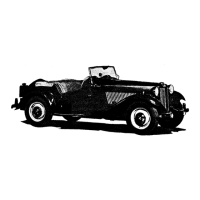-----------~TDE
FLYWHEEL
AND
£LUTCH
E
the
clutch assembly and
the
flywheel.
The
latter
may
be mounted on
the
engine
or
lying on
the
bench, which-
ever
is most convenient. Proceed as follows
:-
Place
the
gauge plate, Part No,
68885
(Fig.
E.6),
centrally
in
the
flywheel In place of
the
driven plate.
Fit
the
cover
assembly
to
the
flywheel by tightening
the
securing bolts
(l)
a
turn
at a
time
by diagonal
selection until
fully
secured.
Place a
stralght·edge
across
the
gauge plate boss
and
the
tip
of one release
lever
(Fig.
E.7).
Flywheel
Securing
bolt
Thrun
spring
Gauge
plate
'-L_-
StraIght-edge
Lever
Adjusting
nut
Lever
eyebolt
" Knife-edge ..
strut
P
ressu
re pIate
Fig.
E.7.
Setting the release levers by means of
the
special
gauge plate, Part No. 68885. and a shoTt straight-edge.
Adjust
the
release lever, if necessary, by
turning
the
adjusting
nut
(14) until
the
tip
of
the
lever is
exactly level with
the
top
of
the
gauge boss.
Adjust
the
remaining levers In a similar manner.
The
setting
should be within ·005 in. (·13 mm.) If
carefully
carried
OUt.
Re-Iock
the
eyebolt
nuts
by
the
same
method
used
by
the
makers (split pin
or
staking).
Slacken
the
securing bolts (2) a
turn
at a
time
by
diagonal selection,
then
remove
the
holdIng screws
and
the
clutch from
the
flywheel'
(I).
Remove
the
gauge plate and reassemble
with
the
actual driven
plate.
Section
&7
REFACING THE DRIVEN PLATE
To
renew
the
facings on
the
driven plate. proceed
as follows
:-
Do
not
punch
out
the
rivets.
Using a
t\ In.
or
4 mm. drill,
remove
each rivet.
Rivet
one
new facing in position, using a blunt-
ended
centre
punch If
the
correct
tool is
not
available
to
roll
the
rivet shanks against
the
plate.
Rivet
the
second facing
onto
the
opposite
side of
the
plate with
the
dearance
holes
over
the
rivet
heads
already formed in fitting
the
first facing.
Mount
the
plate on a mandrel
between
centres
and
check
for
run-out
as
near
the
edge
as
possible;
If
error
Is
more
than
·015 in. (·38 mm.)
dress
over
the
high spots until
true
within this figure.
SootiOD
E.8
SERVICING THE CLUTCH
As
the
clutch facings wear,
the
pressure
plate moves
closer
to
the
flywheel face, and
the
outer
or
shorter
ends
of
the
release levers follow. This causes
the
inner
or
longer
ends
of
the
levers
to
travel
farther
towards
the
gearbox, and decreases
the
clearance
between
the
release lever plate and
the
release bear-
ing.
The
effect on
the
clutch pedal Is
to
decrease
the
clearance
or
free
travel;
in
other
words
it reduces
the
distance
the
clutch pedal moves
forward,
away
from
the
back
stop.
before
the
release bearing comes
into
contact
with
the
release lever plate. Some free
movement
must
always be maintained
here
to
prevent
the
clutch pedal riding against
the
back
stop
and th us
causing
the
clutch
to
slip. This essential free move-
ment
is
restored
by adjusting
the
clutch pedal position.
Excessive pedal
movement
causes coil bindIng of
the
springs and Imposes an undue load on
the
bearing
and on
the
crankshaft, causing excessive and rapid
bearing wear. It
therefore
follows
that
the
required
pedal
travet
Is
the
sum
of
the
two
movements
:-
I. The free movement,
or
travel
necessary
to
take
up
the
clearance
between
the
release bearing
and
the
release
lever
plate, provided to
ensure
that
the
clutch is fully engaged
when
the
foot
is removed from
the
pedal.
2. The effective movement,
or
travel necessary
to
release
the
clutch, l.e,
the
amount
of
effective
pedal
movement
necessary
to
move
the
release
plate
the
distance
required
to
free
the
clutch
completely.
The pedal travel should be limited by the.
front
and back
stops
of
the
clutch pedal,
to
the
correct
amount
indicated. It is essential
that
these
clearances
be
adhered
to,
to
allow
the
dutch
to
be completely
freed, and at
the
same
time
prevent
the
possibility
of damage
to
the
clutch
bearing,
due
to
over-travel.
If any difficulty Is
experienced
in freeing
the
clutch
when
the
correct
release
movement
Is provided, on
no account should efforts be made
to
improve
matters
by
attempting
to
increase
the
effective pedal travel.
E.7
Wishvilles Classic
Automobile Library

